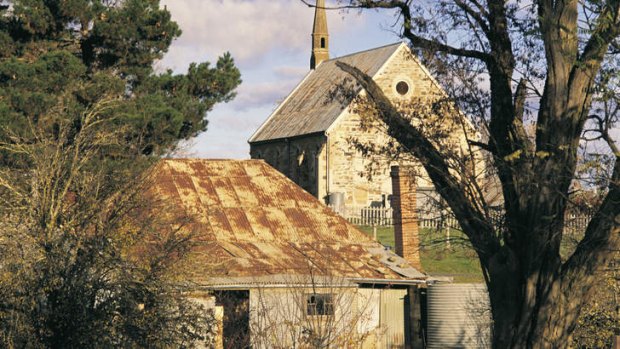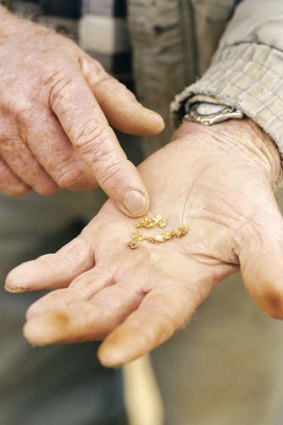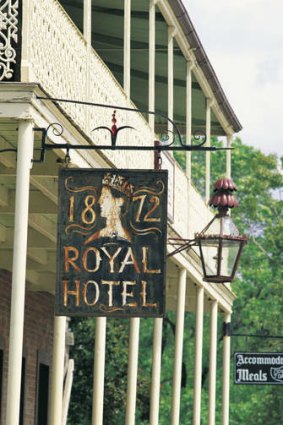
Historic buildings in Hill End.
The history of Hill End has a cast of artists, writers, conmen and desperados, writes Margaret Smith.
'It's the end of the road" is one way to describe the old mining town of Hill End, in the NSW central west. "Hill End is always at the end of everything," is how one resident says it.
It's certainly a place that has fascinated writers, artists, gold seekers, desperados, con men, merchants and historians of all descriptions, since gold was first mined in the 1850s.

A small fortune.
Driving to Hill End from Bathurst takes us through wide-open plains and the rustic village of Sofala, immortalised by Henry Lawson's iconic short stories of misfits and loners.
Anthony Trollope from America visited the region in 1871, and wrote of "parties of men, generally 10 or 12 in number ... leisurely tramping along the road with their swags on their backs".
Then the dusty narrow road curves along the edge of jagged mountains, and almost takes your breath away as you stare at the Turon River valley below.

Local pub the Royal Hotel.
The road was made famous by intrepid bushrangers, who robbed the Cobb & Co passengers at gunpoint. Finally we descend past the old museum into Hill End.
Alternatively, you can drive from Mudgee through handsome land shaped by decades of farming over which crows and corellas circle, and approach Hill End through an avenue of trees arching the road.
You pass numerous dwellings with horses and goats grazing in their large front yards, and the Glendora Campground, where you can pitch a tent or rest a caravan.
Either way you know you have arrived when you see the verandahs of the old Royal Hotel, stone churches and the awnings of the general store.
Immediately, the paintings of Russell Drysdale, Donald Friend, and Jeffrey Smart come to mind. You look down a street and see Drysdale's The Cricketers in your mind's eye.
And everywhere there are gold miners' cottages, some in good shape and others with bush vegetation slowly taking over timber slabs, which were sealed with samplings and mud.
In the 1870s it was a town of more than 8000 people, and their ghosts can be felt in the abandoned mines and historic buildings.
Then the town boasted two newspapers, five banks, eight churches and 28 pubs, with a predominantly male clientele.
It was a multicultural population with Chinese, Europeans and people from all over the world mixing with the settlers, convicts and Aboriginal people. Some became rich but most had to contend with racism, greed and profiteering.
The town was also made famous by the Holtermann photographic collection, and its German creator, Bernardt Holtermann, who in 1872 discovered the largest gold rock in Australia. Like many stories about Hill End, there was a mystery surrounding its birth.
According to local historian and author Brian Hodge, who still lives just outside the town, gold is said to have been first discovered by Aborigines, and not by Lawrence Hargraves, who is now regarded as a charlatan.
Hodge writes that in 1817, Governor Lachlan Macquarie travelled to Bathurst and met a party of Aboriginal men and boys. Macquarie recorded in his diary they are "not at all warlike", and it is said he learnt of the gold then.
Sandra Thompson, Hill End's visitors' discovery ranger, says there are endless stories.
Five generations of her family have lived in Hill End, where they worked as miners and carters, though her parents took her family away for a few years when she was young.
She believes Macquarie did know about the gold, but kept his information secret for fear that Sydney's population would empty in the rush for riches.
Goodwill dissipated with the Wiradjuri people when Macquarie sanctioned reprisal parties against Aborigines who stole sheep from land stolen from them. Governor Brisbane declared martial law in retaliation for raids of attrition by warriors such as Windradyne.
Historian Alan Mayne gives a detailed account. "The first gold boom in the district around Hill End was started by three Aboriginal shepherds, who Europeans called Daniel, Jimmy Irwin and Tommy ... The boom was fuelled by another Aboriginal, who spotted gold at Louisa Creek in July-August 1851, thereby sparking the rush that created Tambaroora goldfield."
Driving to Tambaroora is really like a trip down memory lane.
It's just five kilometres away, with a few old cottages, many ruins, a cemetery and abandoned mine shafts. It once attracted hundreds of Chinese miners and market gardeners who set up camp, and started digging with picks and spades.
When the gold began to run out, very few Chinese stayed and the town died as they left.
Some of their implements and Chinese pottery can be seen at the Visitors' Centre Museum.
Thompson says they survived by growing their own vegetables and eating rabbits, kangaroos and their own livestock, which they brought with them over the mountains. There was also a Chinese temple where Chinese and Europeans smoked locally grown opium.
When things were too tough, miners would commit suicide by jumping down a mine shaft.
Eleven books have been written by Brian Hodge about the area, and he says "there are still lots of things you wouldn't include".
His great-great-grandfather came to the Hill End region in 1852, and the Hodge family has had a rich history to mine.
Hodge studied history at New England University, and then taught history at Broken Hill High School and Sydney Boys' High.
He did much of his research at the Mitchell Library, studying the old newspapers and photographs of the region.
One of the most famous storytellers of Tambaroora and Hill End was the artist Donald Friend, who first visited with Russell Drysdale in 1947. Friend was painted in front of a historic church by Drysdale, and the painting and church are there to see today.
Donald Friend was fascinated by the town's past, and wrote: "Hundreds of men, of all classes, threw up their situations, and leaving their wives and families behind them, started for the diggings."
A small number of women tried to ameliorate diseases of scarlet and thyroid fever, tuberculosis and various infections.
He recalls Harriett Beard, who set up a store on the goldfields in the 1850s.
"When at last a very wealthy woman, she retired, she caused drays loaded with the remaining stock of her store to be sent round the district and divided among her clients as a gift. Then she burnt her account books, cancelling debts, and left the goldfields for good."
Friend bought a wattle and daub miners' cottage with his lover, and stayed for more than 10 years, painting and collecting stories.
He recalls in his diary the Royal Hotel of his day, which today still draws drinkers and diners from near and far. "The place is packed with characters. When we returned in the evening the Hill End Saturday Night Drinkfest was in full swing. The bar is a Hogarthian scene of peasant drinking and merriment. A little man called Tommy who took a fancy to me showed me a nugget of gold, or rather a nob of quartz heavily studded with gold - the bar was very full and so were most of the drinkers."
His audacious record of Hill End was published in 1956 as A Collection of Hillendiana, comprising vast numbers of facts and a considerable amount of fiction. It's illustrated with his wonderful wacky drawings including cottages that look like something out of The Hobbit, kangaroos dancing with humans, a woman being dragged by a scared horse, and all sorts of treasures.
In 1967, the town's administration was taken over by the new National Parks and Wildlife Service, which has kept alive the town's history and preserved the wildlife.
Walking around Hill End today you see king parrots, galahs, white and black cockatoos, wallabies and kangaroos grazing on lawns, none of them perturbed by our human presence. Some seem just as interested in us as we are in them.
Later, walking in an old mine shaft known as the golden gully, with its deep earth walls excavated by miners into all sorts of fanciful shapes, we get lost in the past.
Today, the population of town is about 170 residents, which swells with visitors on weekends.
Some cottages are rented through the National Parks and Wildlife Service, and there's the privately run Cookes cottage, the Hosies bed and breakfast, the rustic Royal Hotel, and the Lodge - a 10-year-old upmarket motel in a bush setting.
Both the hotel and the Lodge have dining rooms, and if you have a thirst, then the watering hole never runs dry.
Sign up for the Traveller Deals newsletter
Get exclusive travel deals delivered straight to your inbox. Sign up now.